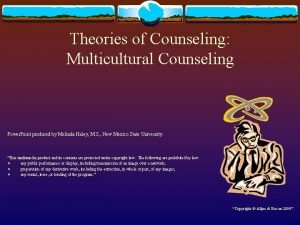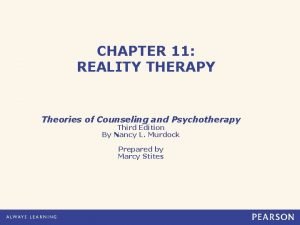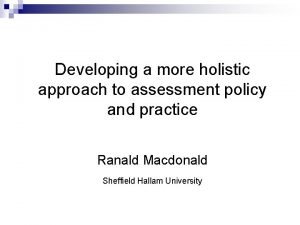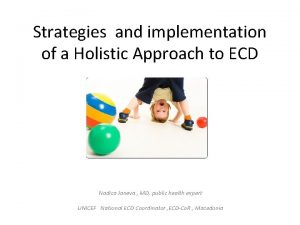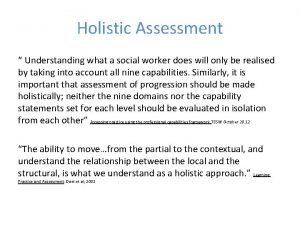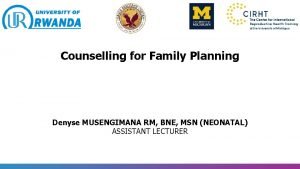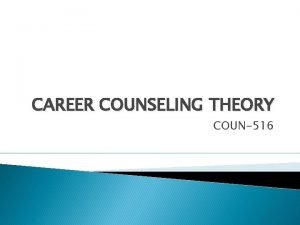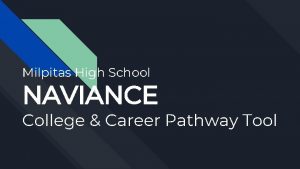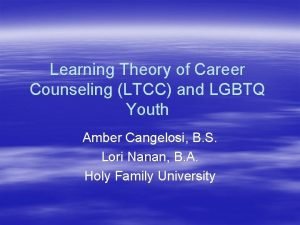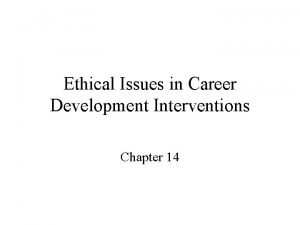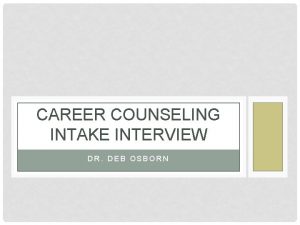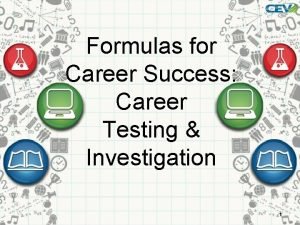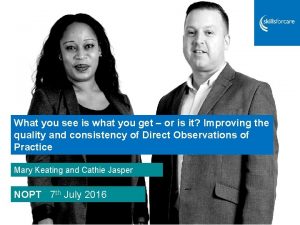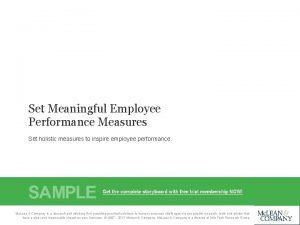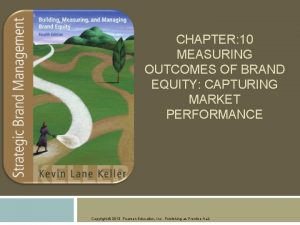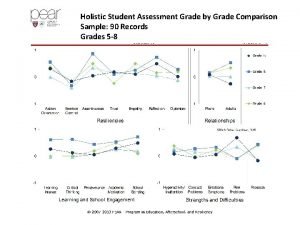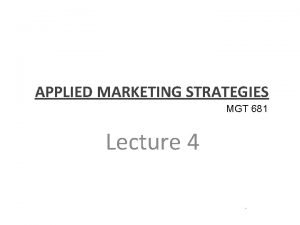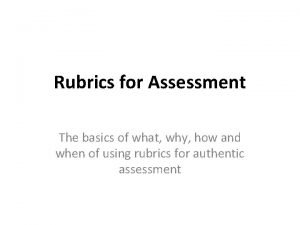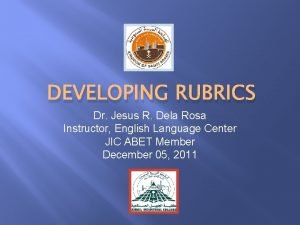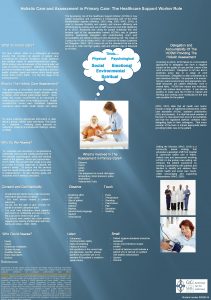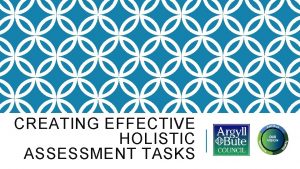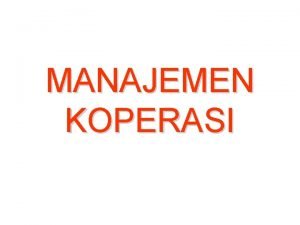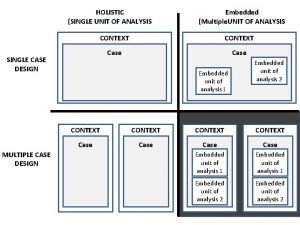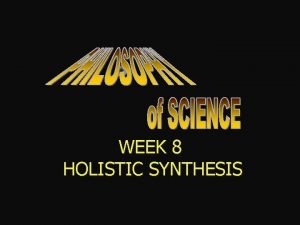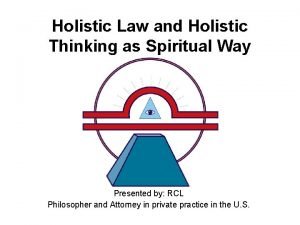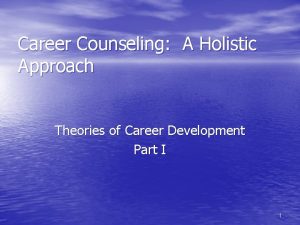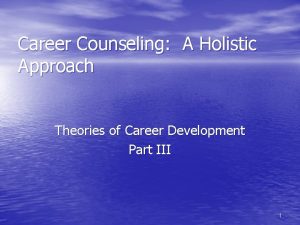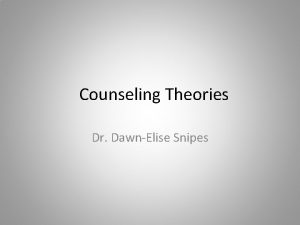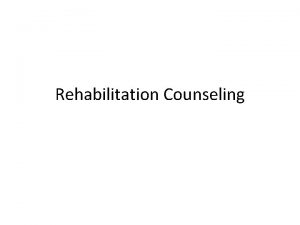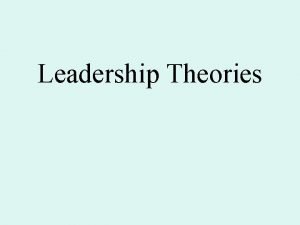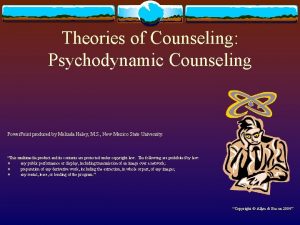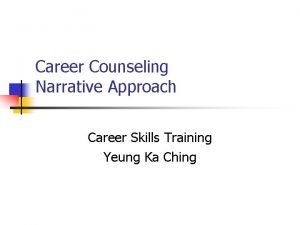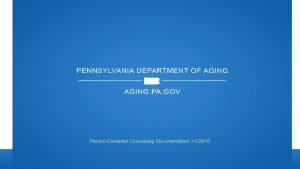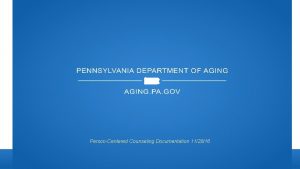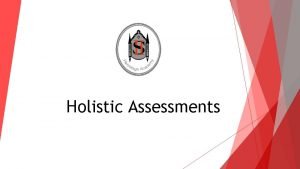Career Counseling A Holistic Approach Theories of Career












































- Slides: 44

Career Counseling: A Holistic Approach Theories of Career Development Part II 1

Social Learning & Cognitive Theories • These theories focus on wide range of variables that affect career choice and maintenance over the life span. • Key elements are problem-solving and decision-making skills. • Career choice also involves the interaction of cognitive and affective processes. 2

Krumboltz’s Learning Theory of Career Counseling • A social-learning theory approach to career • • decision making was first proposed by Krumboltz, Mitchell, and Gelatt (1975) and then several years later by Mitchell and Krumboltz (1990). More recently, Mitchell and Krumboltz (1996) have extended the earlier social-learning theory approach to include Krumboltz’s learning theory of career counseling. Now called the learning theory of career counseling (LTCC). 3

Krumboltz’s Learning Theory of Career Counseling • In LTCC, the process of career development involves four factors: – Genetic endowments and special abilities – Environmental conditions and events – Learning experiences – Task approach skills 4

Krumboltz’s Learning Theory of Career Counseling • Genetic endowments and special abilities include inherited qualities that may set limits on the individual’s career opportunities. • Environmental conditions and events are factors of influence that are often beyond the individual’s control. 5

Krumboltz’s Learning Theory of Career Counseling • Learning experiences include: – Instrumental learning – Associative learning experiences • Task approach skills include the sets of skills the individual has developed. – These sets of skills largely determine the outcome of problems and tasks the individual faces. 6

Krumboltz’s Learning Theory of Career Counseling • Emphasizes the importance of learning experiences and their effect on occupational selection. • Factors that influence preferences in the social-learning model: – Cognitive processes – Interactions in the environment – Inherited personal characteristics 7

Krumboltz’s Learning Theory of Career Counseling • Genetic and environmental factors are also involved. • Other factors influencing preferences are valued role models. • Finally, positive words and images will lead to positive reactions to that occupation. 8

Krumboltz’s Learning Theory of Career Counseling • Learning takes place through observations as well as through direct experiences. • Counselor’s role is to probe assumptions and to explore alternative beliefs and courses of action. • Assisting individuals to understand fully the validity of their beliefs is a major component. 9

Krumboltz’s Learning Theory of Career Counseling • Counselors should address the following problems. – Failure to recognize that a problem exists. – Failure to exert the effort needed to make a decision or solve a problem. – Eliminating a potentially satisfying alternative for inappropriate reasons. – Choosing poor alternatives. – Suffering anxiety over perceived inability to achieve goals. 10

Happenstance Approach Theory • Mitchell, Levin, and Krumboltz (1999) developed • • happenstance approach theory for career counseling. Happenstance approach suggests that counselors are to assist clients respond to conditions and events in a positive manner. Clients are to learn to deal with unplanned events, especially in the give-and-take of life in the 21 st century workforce. 11

Happenstance Approach Theory • Five critical clients skills – Curiosity – Persistence – Flexibility – Optimism – Risk taking 12

Happenstance Approach Theory • Happenstance theory suggests that client learn to approach the future with a positive attitude and the curiosity and optimism that produces positive results. • Foster an attitude that takes advantage of unplanned events. 13

Happenstance Approach Theory • According to Mitchell and Krumboltz (1996), • when people in modern society make career choices, they must cope with four fundamental trends. Career counselors must recognize these trends: – – Clients need to expand their capabilities and interests. Clients need to prepare for changing work tasks. Clients need to be empowered to take action. Career counselors need to play a major role in dealing with all career problems. 14

Happenstance Approach Theory • Many have suggested that career and personal counseling should be integrated. – Many issues call for interventions by the career/personal counselor. • Burnout • Career change • Peer affiliate relationships • Obstacles to career development • The work role and its effect on other life roles are examples • And many others. 15

Career Development from a Cognitive Information Processing Perspective • Based on the cognitive information processing (CIP) theory developed by Peterson, Sampson, and Reardon (1991). 16

CIP is based on the following ten assumptions: • Career choice results from an interaction • • of cognitive and affective processes. Making career choices is a problem solving activity. The capabilities of career problem solvers depend on the availability of cognitive operations as well as knowledge. 17

CIP is based on the following ten assumptions: • Career problem solving is a high-memory • • • -load task. Motivation. Career development involves continual growth and change in knowledge structures. Career identity depends on selfknowledge. 18

CIP is based on the following ten assumptions: • Career maturity depends on one’s ability • • to solve career problems. The ultimate goal is achieved by facilitating growth of informationprocessing skills. Ultimate aim of career counseling is to enhance client’s capabilities as a career problem solver and decision-maker. 19

CIP • The major strategy of career intervention is to provide learning events that will develop the individual’s processing abilities. 20

CIP • The stages of processing information include: – Screening, translating, and encoding input in short-term memory – Then, storing it in long-term memory – Later activating, retrieving, and transforming the input into working memory to arrive at a solution. 21

CIP • Peterson, Sampson, and Reardon stress that • career problem solving is primarily a cognitive process that can be improved through a sequential procedure known as CASVE includes the following processing skills: – – – Communication Analysis Synthesis Valuing Execution 22

23

Pyramid of information-processing domains 24

CIP • Major difference between CIP and others is the role of cognition as a mediating force that leads individuals to greater power and control in determining their own destinies. • Authors have proposed a seven-step sequence for career delivery. See text for example of “Individual Learning Plan. ” 25

A career counseling sequence for individuals 26

Career Development from a Social Cognitive Perspective • According to Lent, Brown, and Hackett (1996), there are three ways to translate and share knowledge with existing theories and emerging ones. 27

Career Development from a Social Cognitive Perspective • The first is to agree on a common meaning for conceptually related concepts, such as self-concept and self-efficacy. – Betz (1992) defines career self-efficacy as “the possibility that low expectations of efficacy with respect to some aspect of career behavior may serve as a detriment to optimal career choice and the development of the individual, ” (p. 24). 28

Self-Efficacy Theory • One of the most promising theories that may • lend itself to addressing gender is Hackett and Betz’s (1981) self-efficacy theory (based primarily on Bandura’s social learning theory). Hackett and Betz (1981) suggest that women who believe they are incapable of performing certain tasks (low self-efficacy) limit their career mobility and restrict their career options. 29

Career Development from a Social Cognitive Perspective • The second way to translate and share • knowledge about existing theories and emerging ones is to fully describe and define common outcomes such as satisfaction and stability, found in a number of theories. Finally, a third way is to fully explain the relationships among such diverse constructs as interests, self-efficacy, abilities, and needs. 30

Social Cognitive Career Theory (SCCT) • The aim is to explain how variables such as • • interests, abilities, and values interrelate and how all variables influence individual growth. Also to delineate the contextual factors (environmental influences) that lead to career outcomes. Also emphasized is the term personal agency. 31

SCCT • Key Theoretical Constructs – The personal determinants of career development have been conceptualized as self -efficacy, outcome expectations, and personal goals. – The “big three” are considered to be building blocks that determine the course of career development and its outcome. 32

SCCT • Self-efficacy is a set of beliefs about a specific performance domain. • Outcome expectations are regarded as personal beliefs about expectations or consequences of behavioral activities. • Personal goals are considered to be guides that sustain behavior. 33

SCCT • Interest Developmental Model – Individuals develop interests through activities in which they view themselves as competent and generally expect valued outcomes. • Attitudes and Values – Values are preferences for particular reinforcers such as money, status, or autonomy. • Gender and Race/Ethnicity – The individual’s socially constructed world, not the inherited biological traits, is the focus of gender and race in the SCCT. 34

SCCT • Choice Model – The choice process is divided into three components: • Establishing a goal • Taking action to implement a choice • Attaining a level of performance that determines the direction of future career behavior 35

SCCT • Choice Model – The pathways to career choice in SCCT are: • Self-efficacy and outcome expectations promote career- related interests • Interests in turn influence goals • Goal-related actions lead to performance experiences • The outcome determines future paths (determined by whether self-efficacy is strengthened or weakened) • Finally, one establishes a career decision or redirects goals. 36

SCCT • Performance Model – A summary description of SCCT theory. – It points out the interplay of ability, selfefficacy, outcome expectations, and the establishment of goals for judging performance. 37

SCCT – Practical Applications • Suggestions include educational programs in • schools that concentrate on developing interests, values, and talents. Individuals who are experiencing great difficulty with career choice or change should be presented with array of occupations that correspond with their abilities and values, but not necessarily with their interests. 38

SCCT – Practical Applications • Strategy used to combat perceived weaknesses • • includes using occupational card sorts. Overcoming barriers to choice and success is a significant goal. School-to-work initiatives include designing skills programs that provide for self-efficacy enhancement, realistic outcome expectations, and goal-setting skills. 39

Summary of Social Learning and Cognitive Theories • Emphasis on self-knowledge. • Information-processing skills of major importance. • Stress importance of human traits such as ability, personality, and values, and suggest research be directed to how these variables interrelate to influence growth and development. 40

Summary of Social Learning and Cognitive Theories • Other important factors are social, cultural, and economic conditions. • Counselors are urged to unearth contextual interactions and relationship between events and experiences of each client. 41

Summary of Social Learning and Cognitive Theories • Self-efficacy is thought to be the result of several factors. • Career beliefs are a core element. • Faulty beliefs are aggressively addressed. • Learning programs are important for increasing range of career choices. • Learning takes place in many ways. 42

Summary of Social Learning and Cognitive Theories • Have clients observe work activities and attempt to learn certain tasks. • Standardized tests used to determine educational and cognitive deficits. • Individual learning program goals and activities designed to debunk faulty thinking. 43

Summary of Social Learning and Cognitive Theories • Learning to process information effectively is a major goal of these theories. • Skills learned in an initial career choice process can be used in the future. • Clients can prepare for future changes in work. • Learning to adapt and adjust is a lifelong endeavor. 44
 Multicultural counseling theories
Multicultural counseling theories 11 theories of counseling
11 theories of counseling Holistic approach to assessment in education
Holistic approach to assessment in education Holistic approach in early childhood education
Holistic approach in early childhood education Holistic in qualitative research
Holistic in qualitative research A worker does 25 j of work
A worker does 25 j of work Gather approach in family planning
Gather approach in family planning Trait and factor theory steps
Trait and factor theory steps Milpitas college counseling
Milpitas college counseling Krumboltz learning theory of career counseling (ltcc)
Krumboltz learning theory of career counseling (ltcc) Career counseling egypt
Career counseling egypt Ethical issues in career counseling
Ethical issues in career counseling Intake interview in counseling
Intake interview in counseling Cognitive approach vs behavioral approach
Cognitive approach vs behavioral approach Avoidance
Avoidance Tony wagner's seven survival skills
Tony wagner's seven survival skills Bandura's reciprocal determinism
Bandura's reciprocal determinism Process of research definition
Process of research definition Difference between virtual circuit and datagram network
Difference between virtual circuit and datagram network Waterfall market entry strategy
Waterfall market entry strategy Traditional approach vs object oriented approach
Traditional approach vs object oriented approach Launchpad fcs
Launchpad fcs Formulas for career success
Formulas for career success Example of holistic assessment
Example of holistic assessment Holistic pediatrics
Holistic pediatrics Holistic measures
Holistic measures Holistic piercings
Holistic piercings How to measure outcomes of brand equity
How to measure outcomes of brand equity Example of holistic assessment
Example of holistic assessment Performance marketing in holistic marketing
Performance marketing in holistic marketing What is performance marketing
What is performance marketing Holistic marketing
Holistic marketing Holistic rubric
Holistic rubric Managing holistic marketing organization
Managing holistic marketing organization Holistic rubric for oral presentation
Holistic rubric for oral presentation Holistic care assessment
Holistic care assessment Holistic assessment examples
Holistic assessment examples Benefits of sukh shanti plant
Benefits of sukh shanti plant Pendekatan manajemen koperasi
Pendekatan manajemen koperasi Single holistic case study
Single holistic case study Energeticism
Energeticism Holistic cannabis academy
Holistic cannabis academy Holistic advancement meaning
Holistic advancement meaning Dance kinesiology definition
Dance kinesiology definition Holistic law
Holistic law
